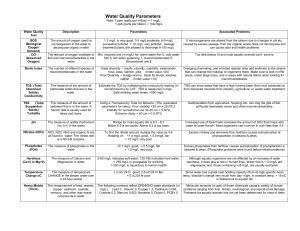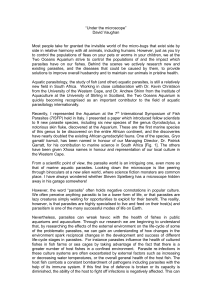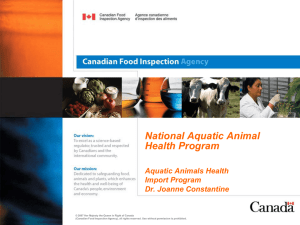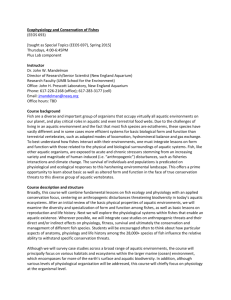freshwater insects & parasites by
advertisement
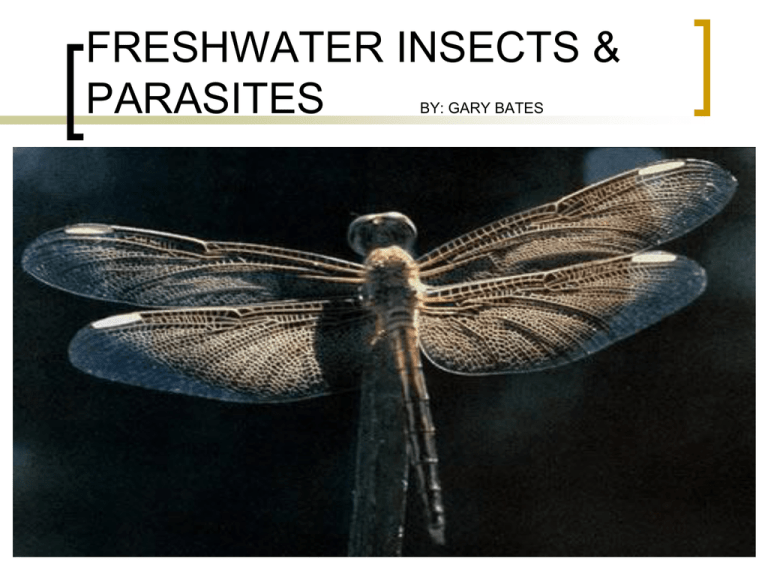
FRESHWATER INSECTS & PARASITES BY: GARY BATES Freshwater Insects & Parasites Gary Bates MS Agriculture with emphasis on Range/Wildlife Management Born & Raised in San Angelo, Texas Graduate of Angelo State University- BS in 2005 Not Taken Biology Course Since 1997 First ever course in aquatics Interested in freshwater habitats for sustained rangeland production Continue on at PhD in Range Science/ grazing behavior & management NOMENCLATURE Kingdom- Animalia Phylum- Anthropoda Some parasites discussed will be from other kingdoms & phylums Anthropoda Classes Arachnida-spiders, ticks,scorpions Crustacea- crawdads Diplopoda- millipede Chilopoda- centipede Insecta (Hexapoda) largest class in the world!!!!!!!!! ARACHNIDA CHARACTERISTICS Two segmented body chephalothorax & head absent antennae legs- eight pair pedipalps- sensory organs for touch and smell Mouth- piercing, sucking, & chewing Can be terrestrial or aquatic Can be herbaceous, predaceous, parasitic, or herbaceous ARACHNIDA Araneida- spiders Acari- ticks, mites Scopionidascorpions Phalangida- daddylong legs Salpugidasunspiders Orders Water Spider Argyroneta aquatica Breathes with spiracles acts like a lung always on bodynot head Plastron- thin film of gas where spiracles open Water Spider Found in freshwater lakes & ponds Carnivorous- water mites, mayfly numphs, etc… Usually lives underwater but may live above the water Unusual Fact- males larger than females Danger from fish and frogs CLASS Insecta (Hexapoda) Three body segments head,thorax,abdomen Antennae present Wings- 2 pair (not all) Legs- 3 pair (6-legshexapode) can be predaceous, scavengers, parasitic, or herbaceous many habitats (they are everywhere you look) Insects Orders Coleoptera- beetles Collembola – springtails Diptera – flies, mosquitos Ephemeroptera- mayflies Hemiptera – true bugs Hymenoptera – wasps,bees,ants Lepidoptera- butterfly,moth Megaloptera- dobsonfly, fishfly Neuroptera- spongillaflies Odonata- dragonflies, damselflies Orthopteragrasshoppers,crickets Plecoptera- stoneflies Coleoptera Beetles Three Aquatic Types - larve & adults all aquatic (water & diving beetles) - larve aquatic (leaf beetles,marsh beetles) - adults aquatic- (moss beetles,weevils Collembola Hydrophobic water surfece Wingless Feed on water surface-algae, fungi,etc… springtails Diptera flies,mosquitos One pair membraneous wings Larvae are wingless are live in aquatic,semiaquatic, or moist habitats Hind wings modified as halteres Ephemeroptera Hind wings modified as halteres Immature- fresh flowing nonpolluted water Naiads (immature stage of growth in water) Air bubble to surface- fly away to nearby leaf Adults do not feed Males die shortly after mating / Females die after depositing eggs Mayfly Hemiptera X-wing pattern Triangular pattern on back Can live underwater or on the surface Tubular proboscis at front of head Antennaesegmented (5) true bugs Hymenoptera bees,wasps,ants Aquatic insects are parasitic on other arthropodes Bees/waspsgrublike Sawfliescatepillar-like “Wasp-Waist” Hymenoptera Lepidoptera 4-5 instars (periods between molts) before pupating in water Adults- live about 2 weeks Larvae damages crops and trees moth/butterfly Megaloptera /dobson fly Largest of aquatic insects All larvae aquatic Feed on other insects fish fly Neuroptera Aquatic immature stage Attracted to lightused as a fish bait Found in flowing rivers and streams spongillaflies Odonata dragonfly Eggs deposited on macrovegetation or in water Damselfly- eggs inserted into stems Dragonfly- eggs laid on surface of water or plants Dragonfly Vs Damselfly Wings held horizontal at rest Strong flyer Eyes not projecting from head Wings held vertically at rest Weak Flyer Eyes bulbous Damselfly Plecoptera stonefly Naiads may take from 2-3 months to a year before becoming adult Crawl out onto rock or vegetation to molt into adults Weak flyers Parasites of Fish Gyrodactyliasis Skin Fluke Parasites of Fish Fish Lice Very small crustacean (shieldshaped) Can be deadly if enters into gills Bite or sting with digestive enzymes to suck out the liquefied fish body matter Argulus Parasites of Fish Anchor worm Look like red or whitishgreen worms Egg sacks may be visible at end of worm Presence of inflammed or red spots May leave ulcer Fish rubbing up against objects Lernaea a crustacean Conclusion Introduction to aquatic entomology and some parasites Large group to study with many areas and closely related organisms References http://www.cals.ncsu.edu/cour se/ent425/library/spotid/index. html http://masetto.esa.catchword.o rg/vl=5763171/cl=12/nw=1/rps v/home.htm http://lhs.lps.org/staff/sputnam/ Ent801/Ento801.htm http://insects.tamu.edu/fieldgui de/ Dr. Keith has a website posted that has most of this material Use these websites for photos and terminology Peterson Field Guides: A Field Guide to Insects


